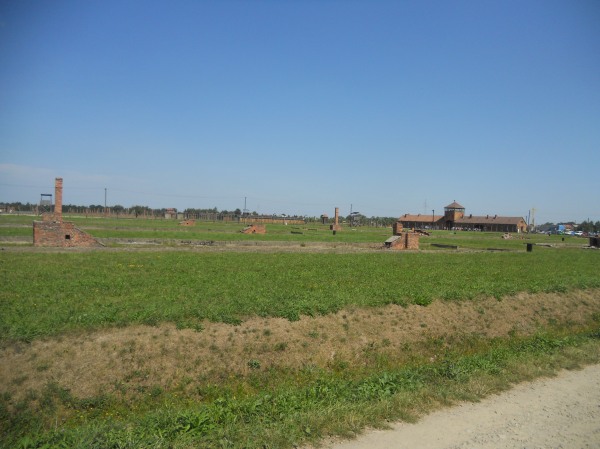When visiting Auschwitz, the weather should be extreme. Hot and beautiful during the summer, or snowy and miserable during the winter. The contrast should jar the visitor or misery should overwhelm and bring a brief rush of understanding. When I visited Dachau, it was sunny, but cold; not extreme enough. Auschwitz felt like I should’ve been on a beach along the Baltic Sea; perfect dissonance. It might be morbid, but I’m not sure morbidity should be avoided.
I tend to romanticize horror and beauty, but that rarely reflects reality. I think of Auschwitz as containing piles of skulls, gaunt bodies, and horrible instances of abuse. Certainly, it did. However, the power of Auschwitz comes from its emptiness. The buildings that remain in Auschwitz I are bare. Auschwitz II—Birkenau—feels like an open-air summer camp; chimneys and bricks mark where barracks used to be, and the crematoria lie in ruins (Nazis blew them up as they deserted the camp when the Soviets approached). The museum at Auschwitz I has huge rooms of human hair, discarded shoes, and luggage. It isn’t relaxing—it’s haunting— but the mind expects something more than what lingers. Ruin, emptiness, and a vague sense of despair don’t match the drama of Band of Brothers, though the implication of that fact might be worse.
The barracks held 700 to 1,000 prisoners; guards didn’t enter them. Order was kept by a few collaborators (kapos), fed well and housed in warmer rooms. Guards kept their distance. Worrying about disease, they relied on kapos to punish other prisoners. Starvation and the psychological effect of being controlled by another person so curtailed the prisoners that Birkenau had only one attempt at revolt. It’s difficult to imagine how that level of death and slavery was possible. It must be a gradual adjustment away from normality, and the dogged persistence of people preferring life to death, gripping hope for what is to become what was.
Auschwitz stands as one of the greatest memorials to the loss of dignity, respect, and humanity. Its power transcends totalitarianism. Throughout the walk around Birkenau, a complete sense of loss envelops you, stronger than the once-electrified barbed-wire fence. The museum provides a few anecdotes about some of the Jews murdered there. Walking the corridors with pictures of the prisoners causes one to pause and reflect on their lives. The young man who lasted three months. The older man (usually Polish or a Gentile, as Jews didn’t survive for long) who somehow made it two years. The woman with her head shaved until her death, nine months later. To think for more than a few minutes about their lives precipitates an existential anguish over the tragedy of a life beaten, degraded, and stolen. The destruction of six million people becomes unfathomable when considering their aspirations, daily lives, and fate wrought by geography and ethnicity. Regardless of will and effort, history can overwhelm justice.
Jews comprised a quarter of the population in Krakow, Poland before the war. Vilnius, Lithuania was known as “Little Jerusalem,” with half the population represented by Jews who filled 105 synagogues. Now, Jewish influence (aside from some buildings and a small monument or two) hardly exists. Europe was disfigured to the point that it’s difficult to notice—let alone envision—what once was and now will never be. Tyranny of war and authoritarianism comes from suppression; it renders impossible what seemed inevitable. Improvement, not recovery, is the alternative. Remembrance is the challenge. How do we understand—how do we teach—what could have been and what was lost? The horror sticks in one’s mind, the brutality leaves its mark, and solemnity emerges, but the emptiness remains. History: Amiss and unmissed. How do we grasp the moral depravity and sense what can never exist?

